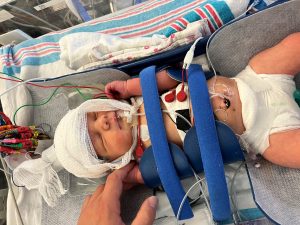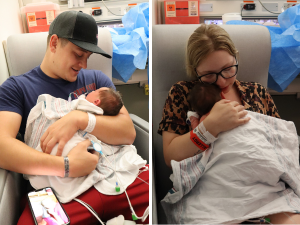Hypoxic Ischemic Encephalopathy Awareness Month: A Family’s Experience
By: Laurie Clark
April 1, 2024
Home » Crouse Connects » Hypoxic Ischemic Encephalopathy Awareness Month: A Family’s Experience

The month of April is Hypoxic Ischemic Encephalopathy (HIE) Awareness Month.
HIE is a brain injury caused by lack of oxygen and restricted blood flow to the brain. It can cause cerebral palsy, epilepsy, hearing and vision impairments, feeding and GI issues, other developmental delays and disabilities and is the second leading cause of infant mortality and lifelong disability worldwide.
At Crouse, our Baker Regional Neonatal Intensive Care Unit cares for 900 infants each year (we call them our Little Fighters). Of those, approximately 25 babies receive a specialized cooling treatment for encephalopathy each year at Crouse.
Valentina’s Birth
Valentina Viscomi was born on September 7, 2022. During labor, her heart rate dropped suddenly and she was delivered by emergency cesarean section. At that point, they discovered her mother had experienced a uterine rupture.
Alexys Viscomi, Valentina’s mother, recalls: “When Valentina was born, she was blue, unresponsive and it was learned her oxygen was cut off when she slipped into my abdomen. She had to be resuscitated. Luckily, we were in the right place at exactly the right time. Dr. Marr and the NICU team immediately intubated Valentina and she was placed on cooling.”
“The team placed Valentina on the cooling protocol due to the uterine rupture causing her blood flow and oxygen levels to drop, her blood gases and APGAR scores were very low and she showed signs of encephalopathy at birth,” says Lily Barres, nurse manager of the Baker Regional NICU.
Cooling Protocol
The cooling protocol consists of bringing the patient’s core temperature to 92.3F degrees for 72 hours then slowly rewarming to 98.6F over the next day and a half. When a baby is cooled, further injury to the brain is prevented by lowering the metabolic demands of the brain. During these days there is intensive monitoring of vital signs, respiratory status, fluid needs, pain, brain activity, and more. It is crucial that the cooling protocol is implemented within the first hours after delivery to fully benefit from the therapy.
half. When a baby is cooled, further injury to the brain is prevented by lowering the metabolic demands of the brain. During these days there is intensive monitoring of vital signs, respiratory status, fluid needs, pain, brain activity, and more. It is crucial that the cooling protocol is implemented within the first hours after delivery to fully benefit from the therapy.
Despite the therapy, Valentina remained at risk for complications related to HIE, including seizures, throughout the cooling and rewarming process. “The first 72 hours of Valentina’s life were some of the most stressful days of our lives,” Alexys says. “She was placed on EEG monitoring to check for seizures, intubated, with nutrition through her lines in her belly button. Her outcome was not known.”
The NICU Experience
Alexys and husband, Adrian say nothing could prepare them for seeing their new baby in this state. The only physical contact they were able to have with Valentina was a touch on her hand for the first few days of her life.
They remember being greeted every day in the NICU by friendly faces and kind, realistic conversations from the NICU team. Zoe, Leanna, Michelle and Chelsea were some of the nurses who cared for Valentina and her parents.
Alexys says: “I remember asking one of our nurses how cooling babies did once they could finally be held. We were very worried how our baby would do with bonding. The nurse told us babies crave the contact and that couldn’t be more true.” After four days, Alexys and Adrian were finally able to hold their baby girl. With the support of the NICU lactation team, nurses, and providers, Alexys was able to pump and exclusively provide breast milk for Valentina when it came time to start her feedings, essential for these infants.
Since neurological deficits can be associated with encephalopathy, follow up includes an MRI and a detailed neurological exam before discharge. Assessment of cognitive, language and motor development is performed at six & 24 months of age by the neonatal developmental follow up team.
Understanding Their Future
 “From our understanding, the MRI would give us a lot of information of how severe the hypoxia was and a glimpse of what our future could entail with our new baby. We were not spared any possibilities. Adrian and I spent a lot of time talking about the unknown, holding our baby skin to skin each time. Valentina had a big sister at home waiting for her, waiting to love and play with her as she got bigger. We decide that no matter what the MRI results showed, our baby would get to meet her big sister and grow up and play with her in any way she could,” Alexys says.
“From our understanding, the MRI would give us a lot of information of how severe the hypoxia was and a glimpse of what our future could entail with our new baby. We were not spared any possibilities. Adrian and I spent a lot of time talking about the unknown, holding our baby skin to skin each time. Valentina had a big sister at home waiting for her, waiting to love and play with her as she got bigger. We decide that no matter what the MRI results showed, our baby would get to meet her big sister and grow up and play with her in any way she could,” Alexys says.
Valentina continued to improve and, after nine days in the Crouse NICU, Alexys and Adrian were finally able to take their baby home.
Valentina’s MRI and neurological exam were normal. She measured on the high-end of normal at her 6 month follow-up. “Our baby was perfect,” Alexys says.
A Happy, Healthy Toddler
The family is happy to share that today Valentina is right on track with all of her milestones.
“Valentina tries her very hardest to keep up with her big sister. She is happy, smart, and very attached to us. Valentina is perfect and healthy thanks to the HIE protocol,” Alexys says.
“The rapid decision making and immediate implementation of the cooling protocol by the NICU team, and the meticulous and compassionate care she received during her NICU stay were vital to her successful recovery,” says Barres.
Alexys and Adrian say, “The cooling protocol is the reason Valentina is here today. Our family is forever grateful.”
Laurie Clark is the Director of Communications Crouse Health.
Categories: Crouse Little Fighters, Maternity, Patient Story
Share this
